Chapter 7: Evoking Expression and Emotion
Observing Emotions and Moods
Visualization
Involving Your Subjects with Nature
Studying Body Language, Gestures, and Movement
Telling a Story with Your Photographs
The Psychology of Photographing Children
As you look through photographs, whether they are your own family photographs, a friend’s collection, or even magazine images, you intuitively flip through them at a certain pace. Every so often you might come across one that stops you, slows you down, and invites you to explore or engage more deeply. It might make you smile, think for a minute, or take you back to a place in time. What a wonderful exercise this is to hone your own observation skills and to see what pulls you in. The chances are very good that the photograph that stops you or slows you down contains something profound or alluring in the expression, mood, and emotion. This is particularly true in children’s photography. Children’s expressions and emotions are usually close to the surface and readily available. As a children’s photographer, you just need to be there, to witness, and to capture, what is offered so freely.
“I think that emotional content is an image’s most important element, regardless of the photographic technique. Much of the work I see these days lacks the emotional impact to draw a reaction from viewers, or remain in their hearts. ~Anne Geddes
The great advantage of digital photography over film (yes, film is still used) is that you can be spontaneous and capture special moments and a child’s natural enthusiasm, as in 7-1 and 7-2, without the high cost of processing. The technology offers you the opportunity to learn as you photograph, and reviewing the immediate results allows you to erase and try again. For those who learned to photograph with film, this convenience is really a dream come true.
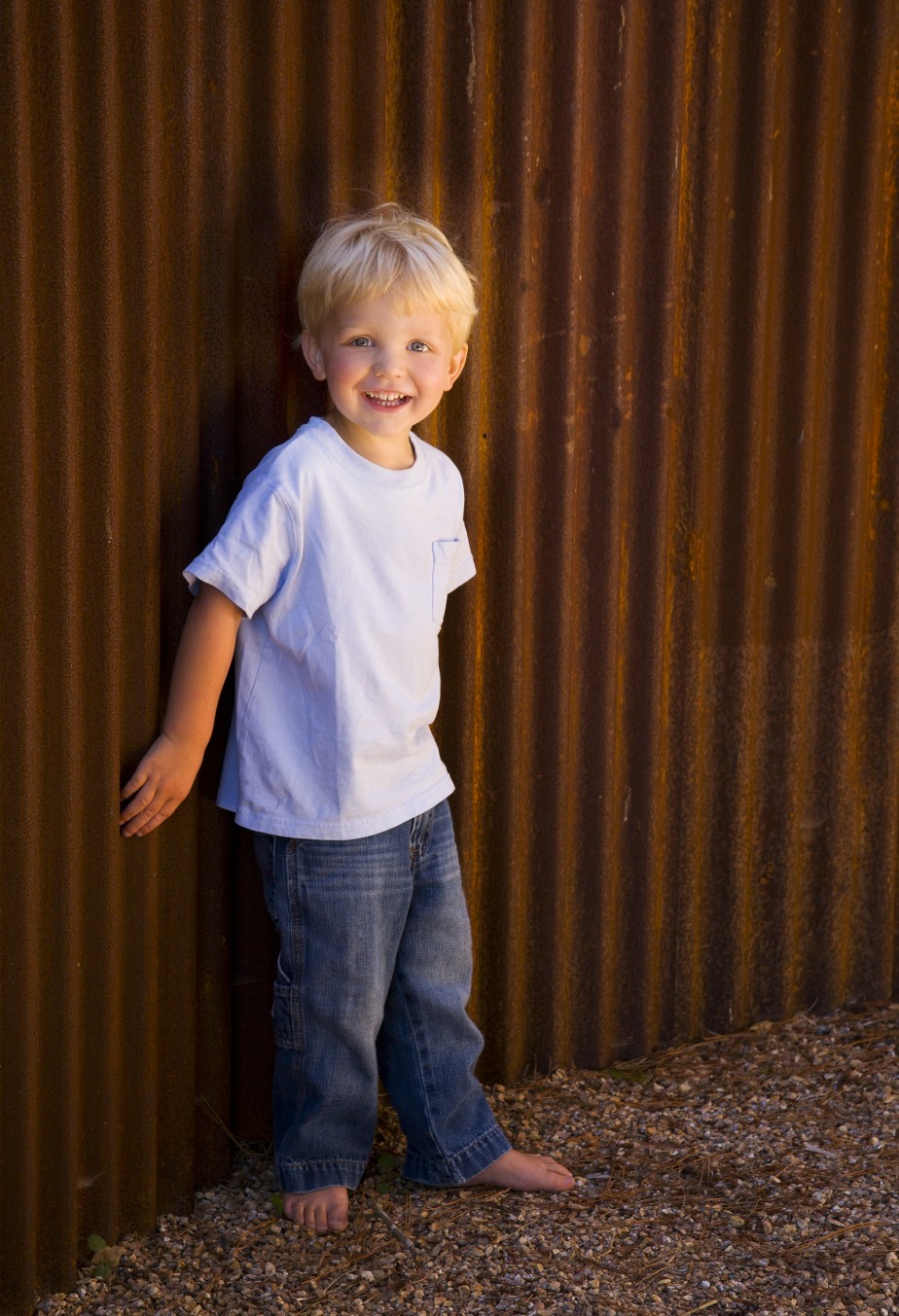
7-1
ABOUT THIS PHOTO The energy and spirit of this sparkling little guy flows in this image, and the warmth of the contemporary metal wall adds an appropriate glow. Taken at ISO 800, f/7.1, and 1/80 second. ©Ginny Felch / www.photographingchildren.com
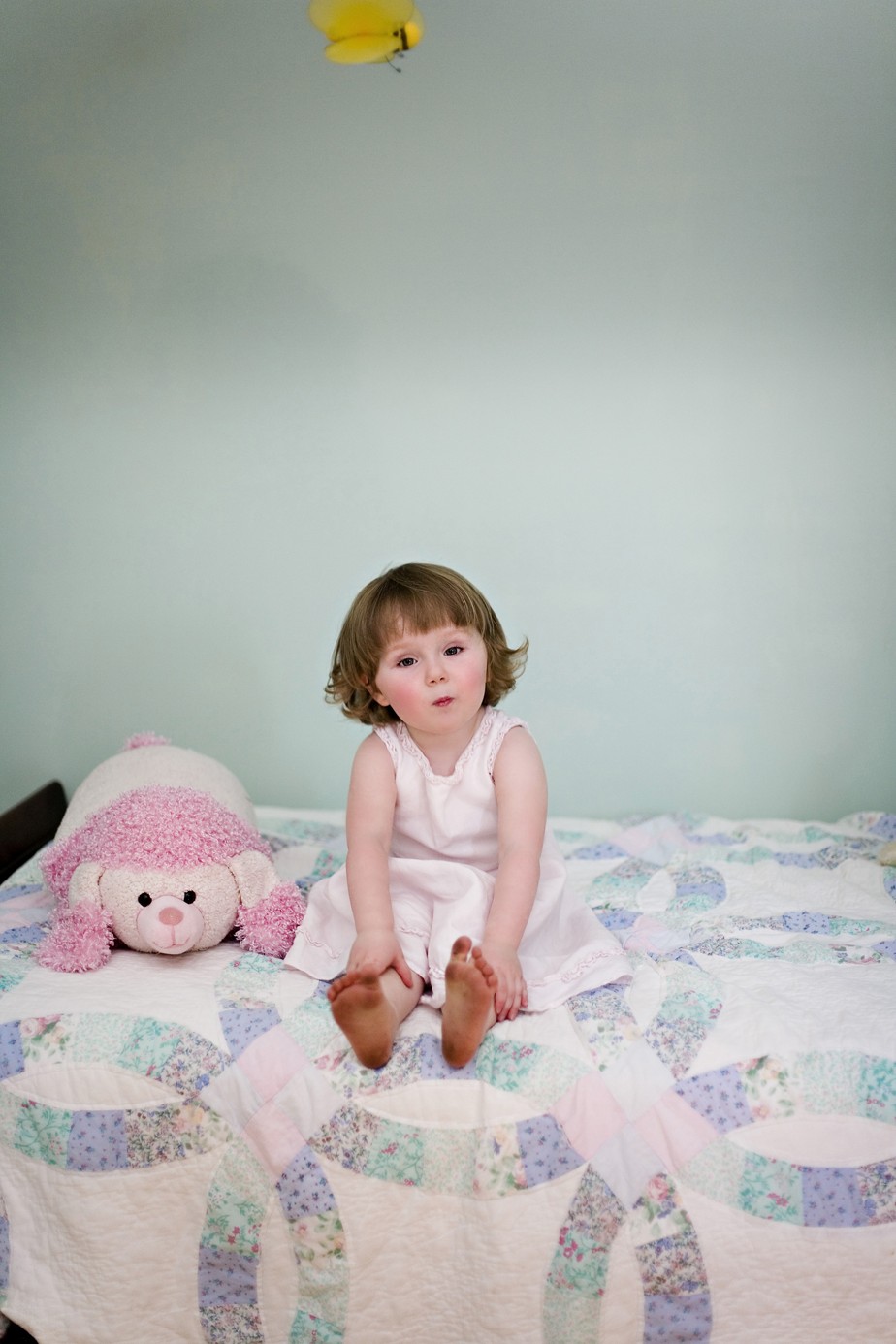
7-2
ABOUT THIS PHOTO Pictured with a distinctive toy and quilt, this girl’s body language and expression are very natural and characteristic of her age. Her dirty feet help tell the story. Taken at ISO 400, f/1.8, and 1/80 second. ©Marianne Drenthe / www.marmaladephotography.com
Observing Emotions and Moods
When photographing children, the elements of expression, emotion, and mood are of utmost importance. Some expressions or moods you might observe include:
• Busy or preoccupied
• Curiosity
• Daydreaming
• Delight
• Engagement
• Flirtatiousness
• Frustration (as in 7-3)
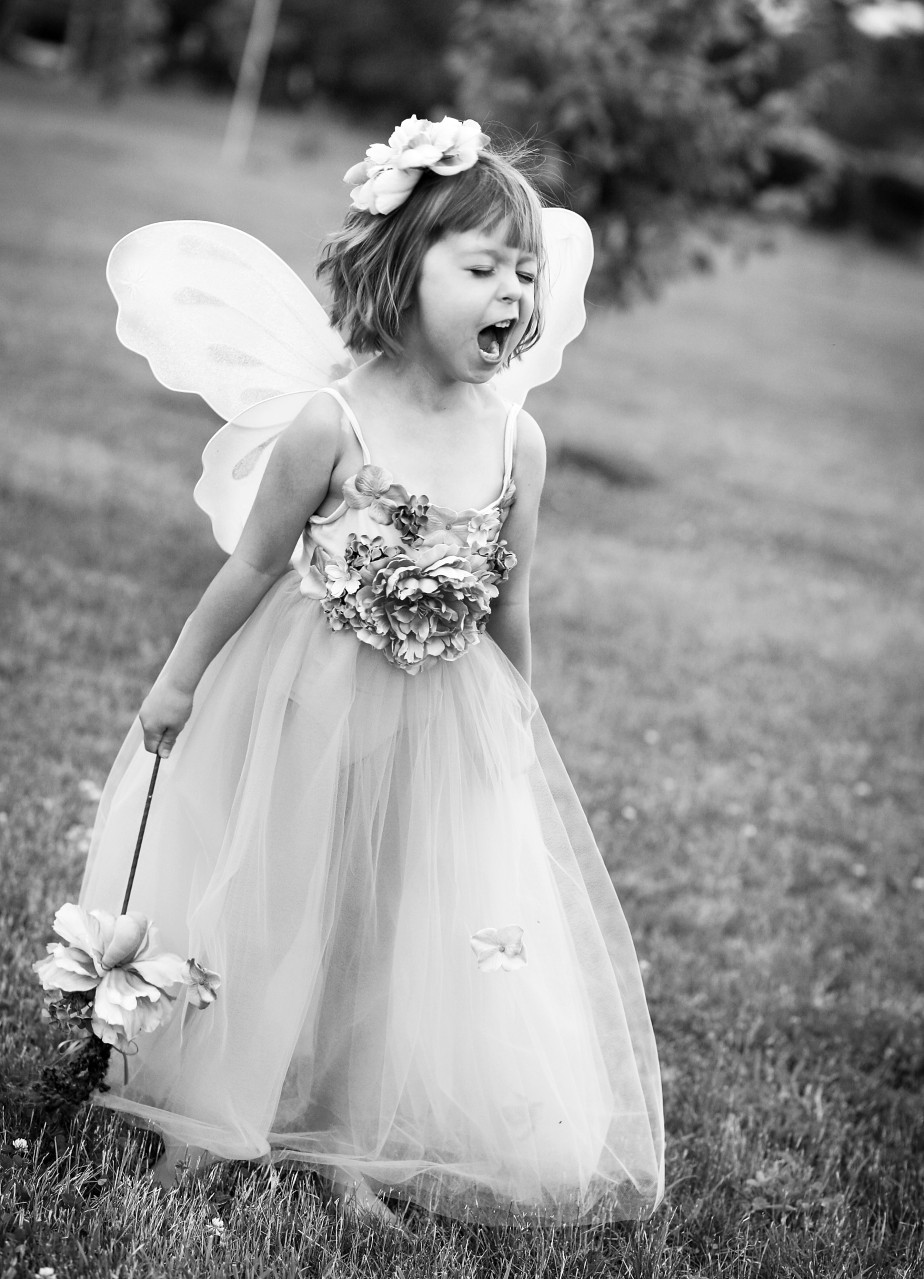
7-3
ABOUT THIS PHOTO Even a wee temper tantrum can make a memorable and amusing photograph for the archives. Taken at ISO 640, f/2.8, and 1/250 second. ©Jen Sherrick / www.jensherrickphotography.com
• Intrigue
• Involvement
• Joy (as in 7-4)

7-4
ABOUT THIS PHOTO Cookies and milk! Pure joy, contentment, and a little bit of silliness defines this expressive image. Taken at ISO 100, f/8.0, and 1/250/ second. ©Barbara Peacock / www.barbarapeacock.com
• Observing
• Playfulness
• Pouting (7-5)

7-5
ABOUT THIS PHOTO Whose heart couldn’t be won over by this little girl’s sullen expression — her feelings are shown in every inch of her beautiful face. Taken at ISO 400, f/1.8, and 1/6400 second. ©Jen Carver / www.jencarverphotography.com
• Restfulness, peacefulness, sleepiness
• Surprise
• Tenderness
• Thoughtfulness
“You are the camera, your eyes are the shutters. What you absorb through them is what you paint, and it’s you that is mixing the colors, not the camera.” ~Richard F. Barber
Visualization
If you are a parent, you have probably stumbled on many instances when you wish you had a camera in your hand. How many times have you looked in the rearview mirror of your car and seen the soft, round cheeks of your sleeping toddler in the backseat. Wouldn’t it be great if all you had to do was blink and a photo would be recorded with all the emotion you were feeling about that person at the moment? Actually, practice in visualizing these moments makes it far more likely that you can capture them in the future. As you go about your day and see children around you, compose and mentally click off a few frames; it will make you a better photographer when you actually get the camera in your hands.
In an ideal world, you would just come upon “the moment” and photograph it, but those kinds of happy accidents are few and far between. It is more likely that you either won’t have your camera with you, or that the moment you turn toward the subject, all spontaneity dissolves, and the magic moment disappears, only to become another beautiful memory.
If you’ve ever tried to recreate a moment just to get the photo, you know that, most of the time, it just doesn’t work. However, you can remember the feeling of that moment and try to pull it out of your bag of tricks for the next time.
Take your camera, even if it’s your cell phone’s camera, everywhere you go with your child, and you will have opportunities galore to capture innumerable precious moments. Your kids will think of the camera as part of their daily life. They will quit mugging and go about their business, which is exactly what you want.
The following sections explore ways to encourage, create, and capture these magic moments while photographing children.
Revealing the eyes: Gateway to the soul
The anonymous quote varies: Eyes are the gateway to the soul, the mirror of the soul, or the windows of the soul. The concept remains the same and is paramount when photographing children. In portraiture, the face is the most expressive part of the body, and of the face, the eyes are most important. You might be forgiven if you get any other part of the image out of focus, though not the eyes. Pay close attention to how the light is illuminating the child’s eyes as well. Look for the catchlights — the little white reflections in the eyes that show life and sparkle. Very often it’s just a matter of turning the child to get the light just right in his or her eyes.
When school photographers and, in fact, most photographers and parents, choose to show children with big, squinty-eyed grins, it makes everyone feel good. The universal appeal of a happy child can’t be disputed, but at least consider the possibility that some appealing alternatives exist.
Take into consideration that when a child is in full-smile mode, the facial muscles are contracted, and the eyes become smaller, less open. Are there other alternatives that you haven’t explored that could convey the personality of the child as well as, or better than, the full, cheesy grin? A child’s face in repose is often the most revealing of the eyes and personality.
Don’t be disappointed if a child you’re photographing covers his eyes and shows his bashfulness, as in 7-6. The picture of this little boy turned out to be very charming and a true reflection of his personality at age 3.
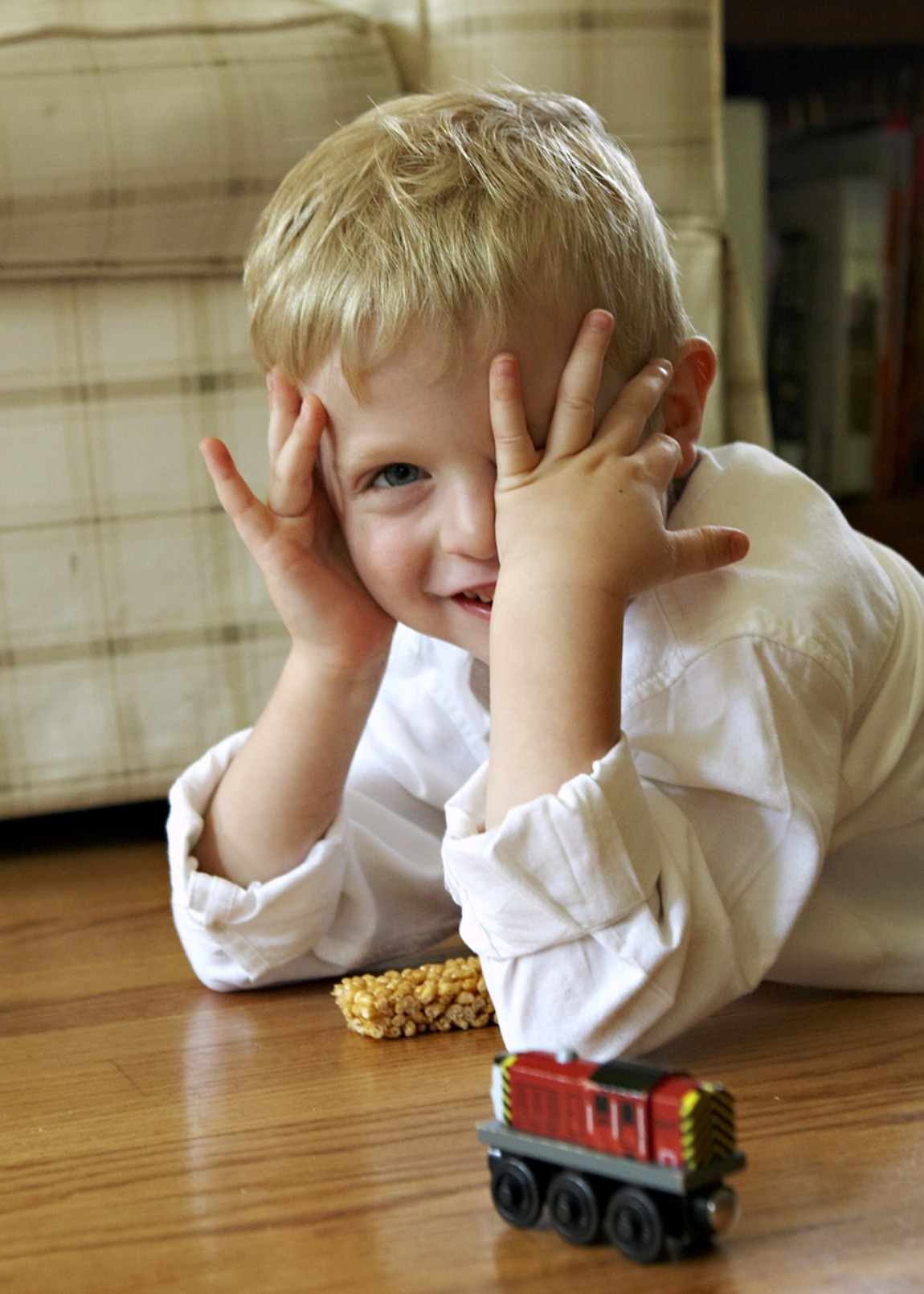
7-6
ABOUT THIS PHOTO Getting down on the floor with a child is key to making him feel comfortable with you. Taken at ISO 640, f/4.0, and 1/60 second. ©Melanie Sikma / www.melaniesphotos.com
The girl in 7-7 has a dreamy look in her eyes. The fact that she is looking right in to the photographer’s eyes conveys a sense of trust and openness. Notice how her eyes are big and bright, and her facial expression is soft.
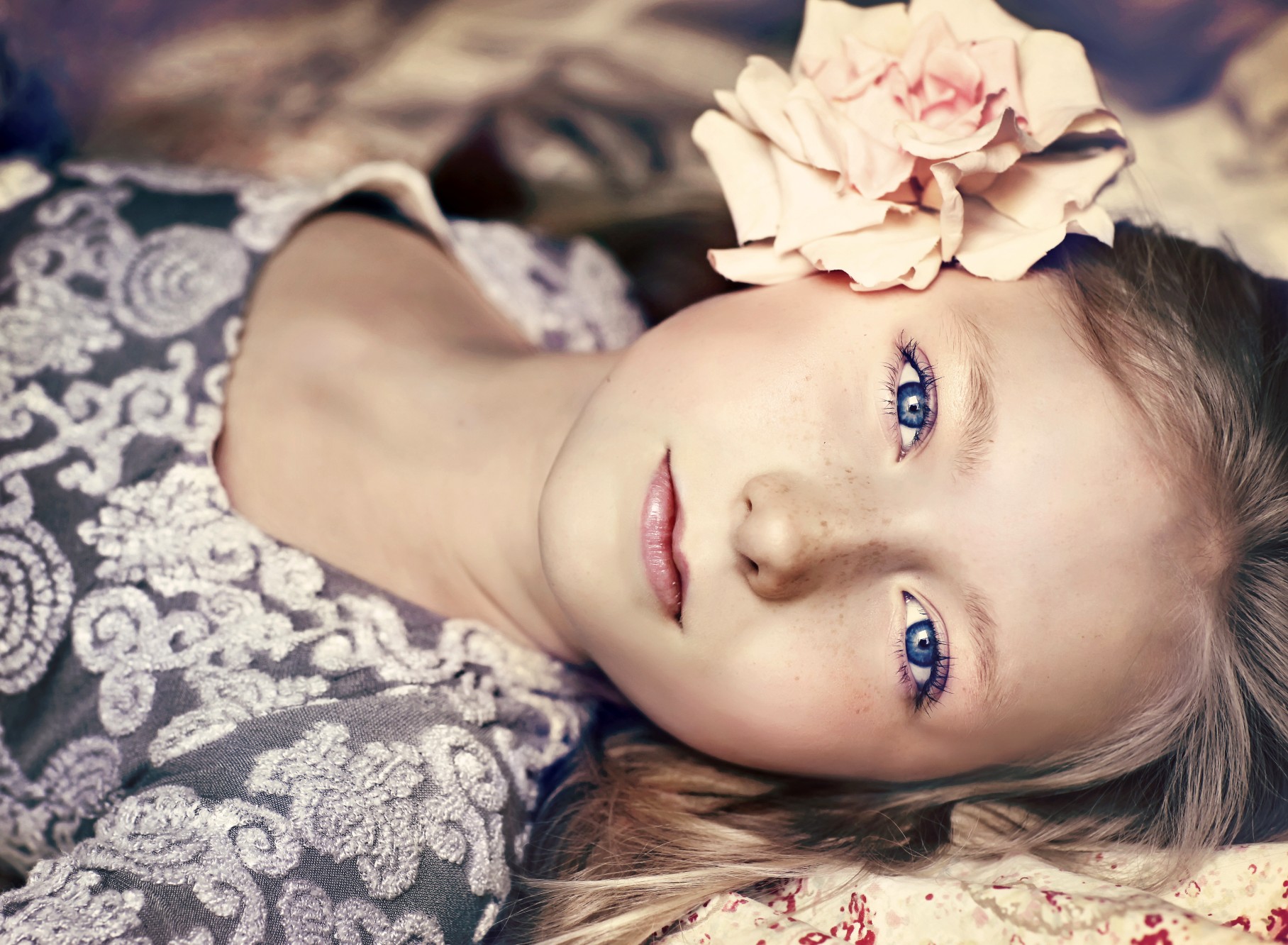
7-7
ABOUT THIS PHOTO Dreamy eyes of a young girl in repose are captured in a romantic and vintage style. Taken at ISO 100, f/3.5, and 1/125 second. ©Abi Campbell / www.abicampbellphotography.com
Most children eventually become comfortable with having their picture taken, as you can see in 7-8. This young boy has a gleam in his eyes because he was given time to get to know the photographer and to relax. A typical photography session can often take an hour or more to achieve photographs like these.
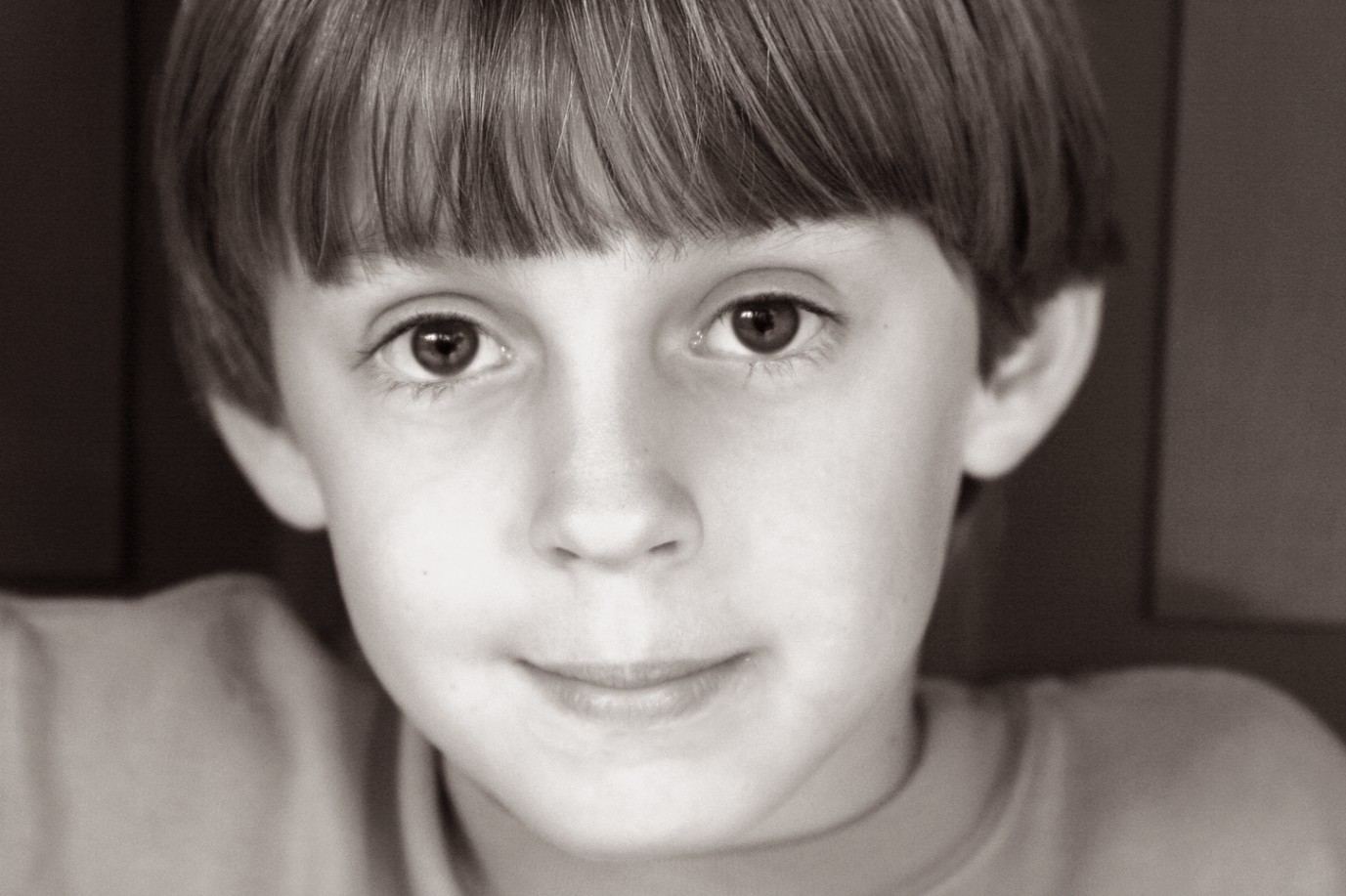
7-8
ABOUT THIS PHOTO My nephew Benjamin exhibits a savvy yet elfish sweetness that beautifully reveals his nature. His dark and penetrating eyes convey openness and trust. Taken at ISO 800, f/5.6, and 1/50 second. ©Ginny Felch / www.photographingchildren.com
Toddlers can be a joy to work with, especially if you can distract their attention away from the camera. You can observe their quirky expressions and movements. The redhead in 7-9 is looking wistfully at the photographer. Notice that the image is cropped closely to emphasize his expression.
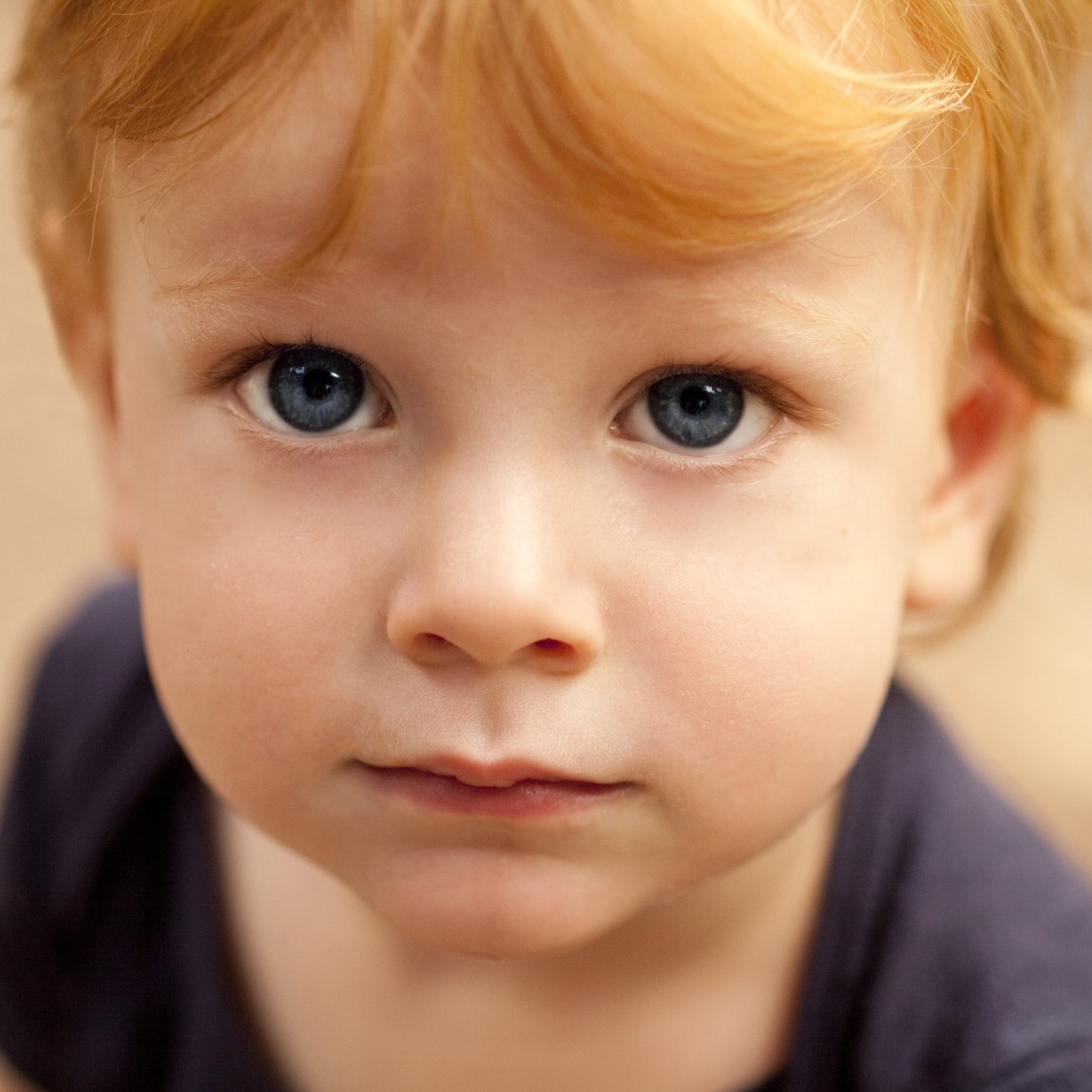
7-9
ABOUT THIS PHOTO Could you look into these eyes and not feel a connection with this wide-eyed, penetrating expression? Well, I couldn’t, but I’m his “Gammy!” Taken at ISO 400, f/3.2, and 1/200 second. ©Ginny Felch / www.photographingchildren.com
Don’t be afraid to make the face and eyes the focal point of the image so that they take up most of the frame. Sometimes, beginning photographers believe that they need to include the entire body. That’s not necessary. Getting up close and personal can result in images that are more visually interesting and intimate.
“Children are natural Zen masters; their world is brand-new in each and every moment.” ~John Bradshaw, author and philosopher
When a child is gazing, observing, listening, or thinking, the eyes are generally wide open, and the face is soft and relaxed, as in 7-10 and 7-11. If you can encourage those moments while making a photograph, by all means do so.
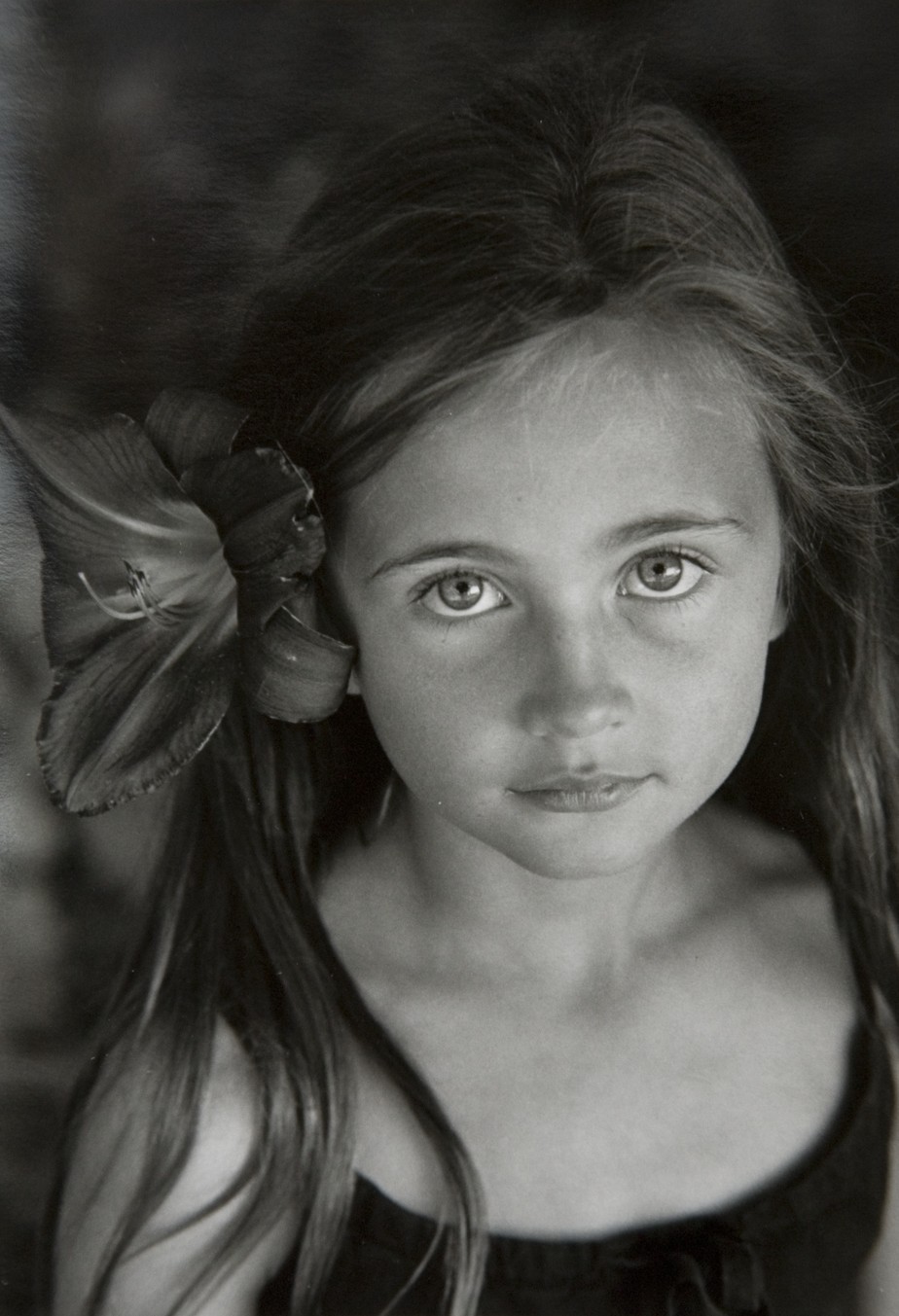
7-10
ABOUT THIS PHOTO This reflective and musing expression really draws you into this portrait of the little girl in the garden. The circular line of her shirt frames her face delicately. Taken at ISO 320, f/5.6, and 1/125 second. ©Patrisha McLean / www.patrishamclean.com
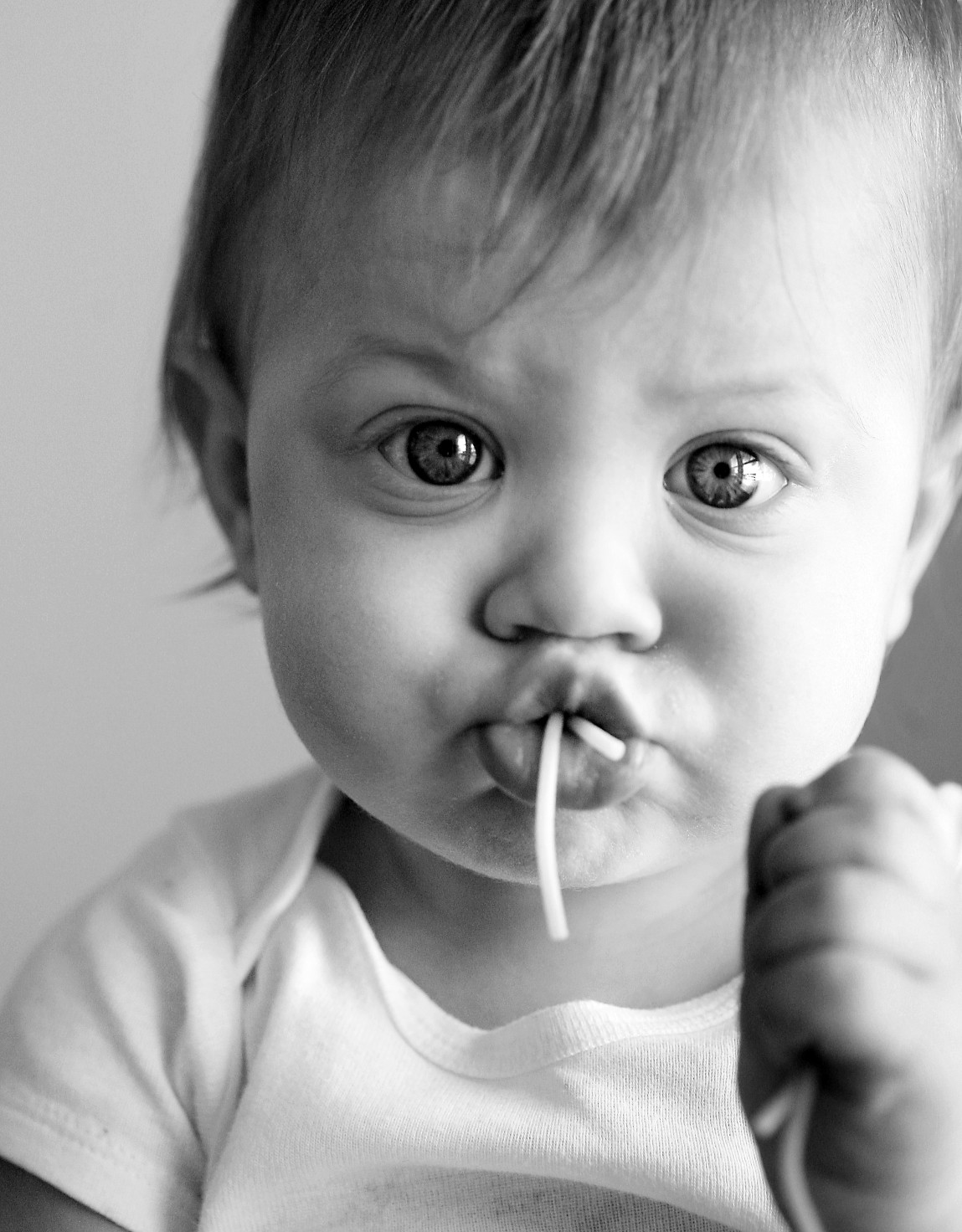
7-11
ABOUT THIS PHOTO Perhaps his first experience with spaghetti evoked this perplexed little fella’s expression. Taken at ISO 1000, f/3.5, and 1/250 second. ©Jen Sherrick / www.jensherrickphotography.com
After you go beyond the fear that you should be making the child smile or laugh, you might be pleasantly surprised by the character and soulfulness that comes forth in your imagery.
Capturing the perfect smile
Smiles are okay, too, if they are not forced just for the photograph. Even if you choose to have children smile, try to find the moment in which the smiles are subtle or natural looking, as in 7-12.
Of course, a fine line exists between pensiveness and petulance, and you learn to discern the difference with experience. This difference often lies in what could be called “sweetness.” When a child is looking at you, all it might take to evoke that sweetness is a little smile of your own or a subtle tilt of your head.
Involving Your Subjects with Nature
When you are outside with a child, isn’t it ironic to see what attracts her? You brought along the bubbles, balloons, and other entertainment only to find that she looks down, picks up an interesting rock or a broken shell, tosses it, smells or tastes it, and absorbs it in any way she can. You planned the trickery, and it didn’t work!
In 7-13, a magical moment was created when this little girl discovered a beach treasure and became absorbed with it. Try to avoid reverting to “Put that down; it’s dirty,” or “Look at the red balloon.” You might lose the chance to observe and capture a child full of wonder.
A child sees a blue bird, skips over to try to touch it, and then plops down in the tickly grass, getting grass stains on her clean shorts. That’s when to click the shutter and thank your lucky stars for the gift of the expressiveness of childhood (if you can just get the mothers to play along).
When photographing children in nature, please be wise, careful, and safe. Don’t leave toddlers unsupervised and watch out for prickly or poisonous plants, snakes, and other intruders. Work with an assistant if you want to be extra cautious.

7-12
ABOUT THIS PHOTO The photographer has evidently set things up for a hot afternoon play fest, and that is exactly what we see here. The boys are unabashedly and naturally going for the fun! Taken at ISO 640, f/6.3, and 1/250 second. ©Mary Schannen / www.melangephoto.com
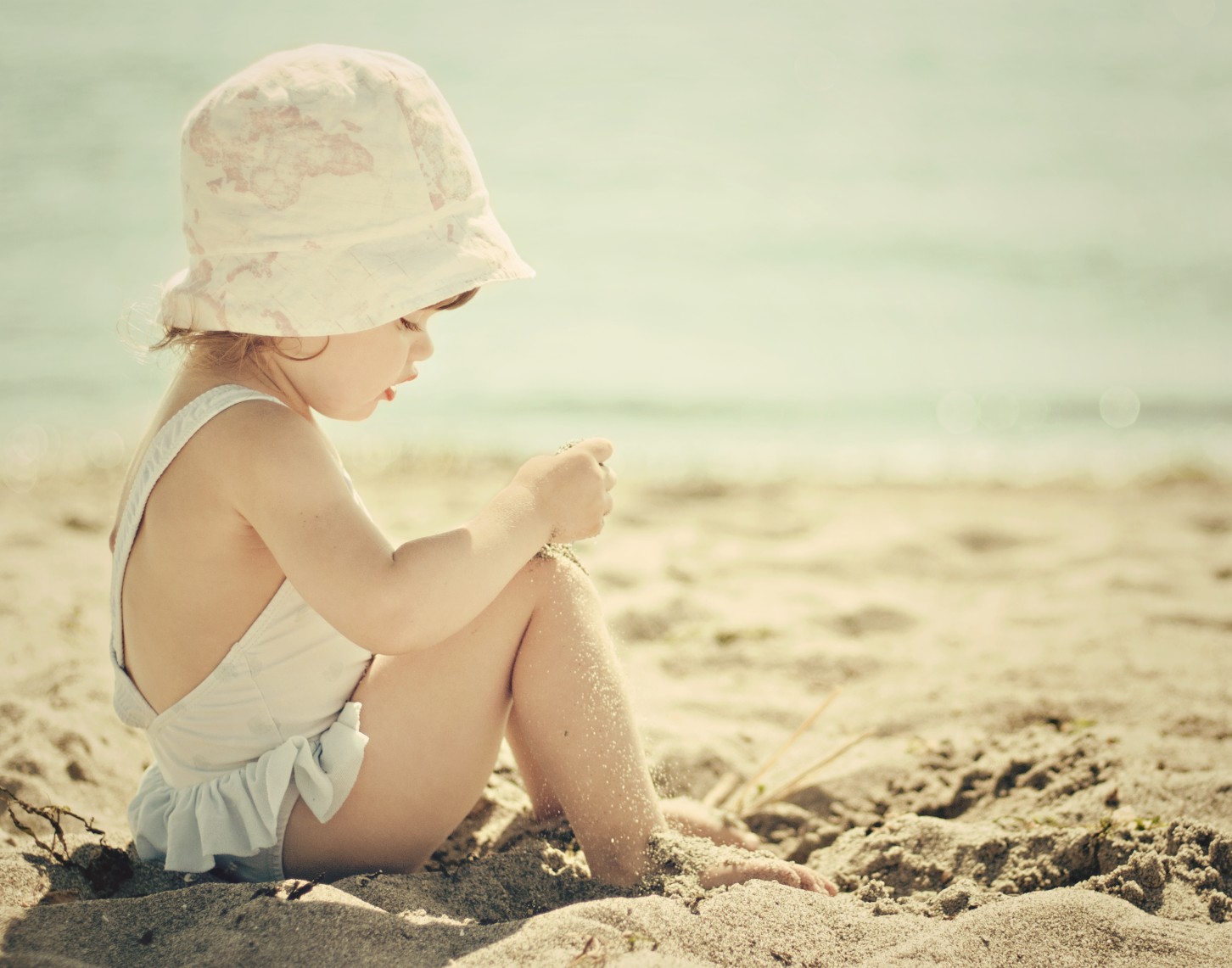
7-13
ABOUT THIS PHOTO A quiet and involved moment at the beach reminiscent of a vintage illustration was beautifully composed by the photographer. Florabella Vintage action, Summer II was used creatively in post-processing. (See Chapter 11 for more ideas.) Taken at ISO 200, f/2.0, and 1/3200 second. ©Valeria Spring / www.theredballoonphotography.com
Are you getting it? Don’t fight the child’s natural instinct for wonder and play; join in — even anticipate and encourage it. What is more interesting in your photograph, a red balloon or a seashell? I make this point here and repeat it many times: Plan it, find the light, be prepared, and then let go. Let go and enjoy the spontaneity and remarkable whimsy of the child.
When you are at the beach or the park, find a location where the light is compelling and settle into the spot with your subject, as in 7-14, where the light is hitting the side of the child’s face while she entertains herself with a dandelion.
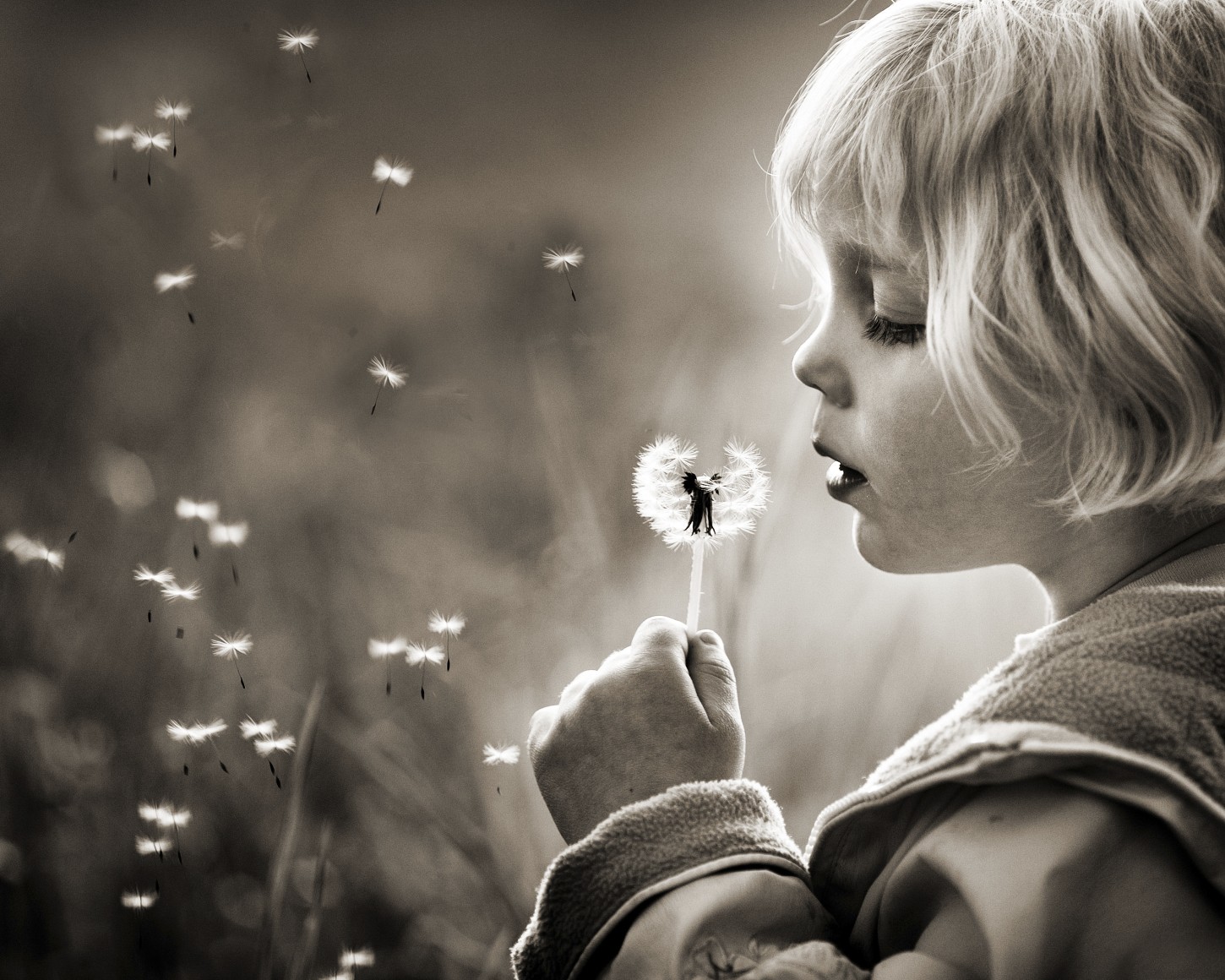
7-14
ABOUT THIS PHOTO The photographer caught this child in the moment, as she was blowing on dandelion seeds, intentionally taking advantage of the late afternoon angle of the sun for stunning rim light. Taken at ISO 320, f/3.2, and 1/125 second. ©Michelle Walker / www.walkerportraits.com
Find a comfortable place to sit down on the grass, on a rock, or stump. Try to keep your voice at a whisper. “Shhh, listen! Tell me what you hear.” The child will quiet down, perhaps widen his eyes, maybe look a bit to the side with his eyes, and begin to listen.
Wherever you are, there will always be something to listen to. It might be the bird chirping, the branches scratching together, a truck honking, or a dog barking. In that very brief moment when the child makes the switch from being conscious of having his photograph taken to the quiet act of listening, you can capture some natural, candid, and expansive expressions.
In 7-15, the children are so engaged in nature or with each other that they are no longer self-conscious that their picture is being taken.
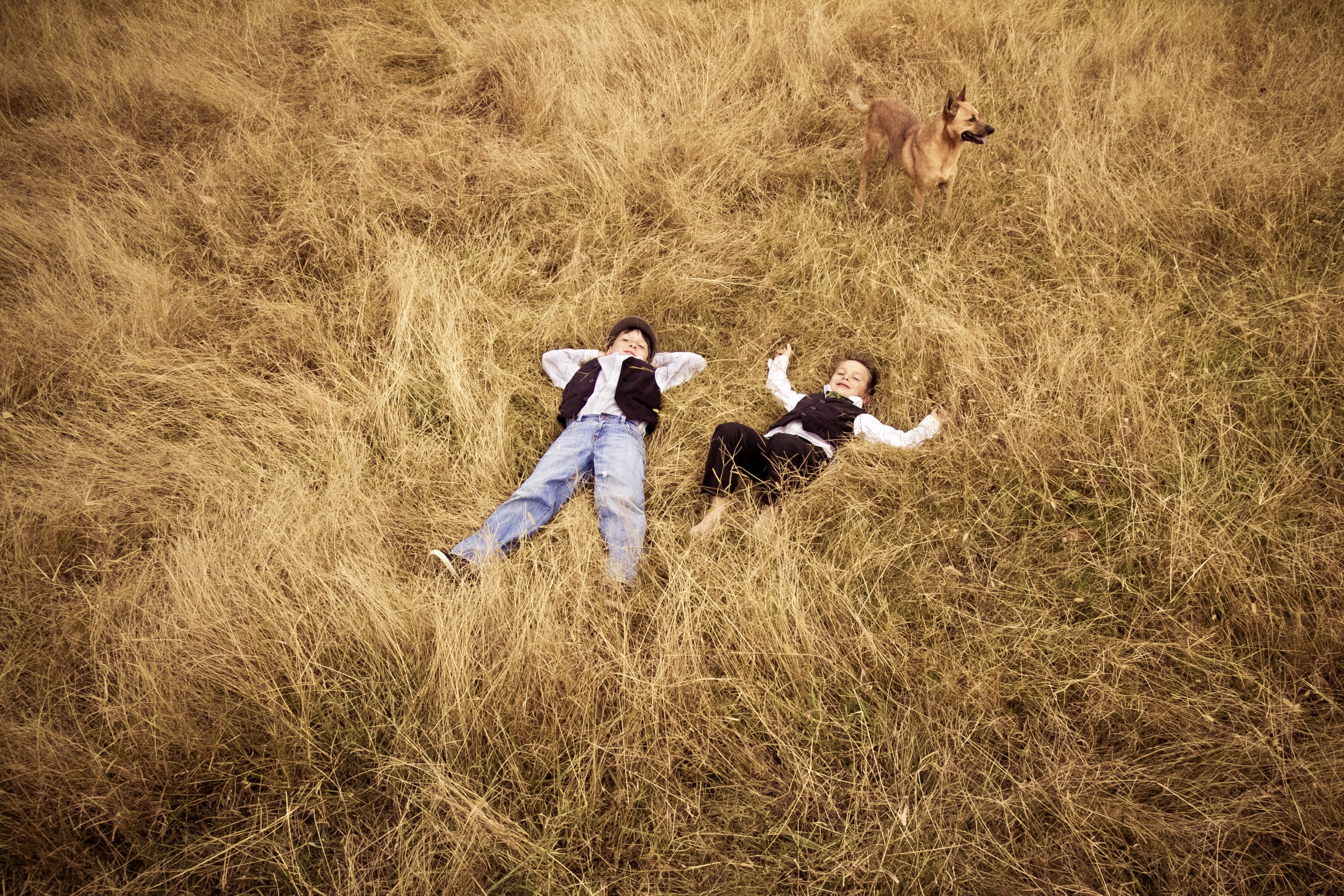
7-15
ABOUT THIS PHOTO You can see a charming unity between these siblings lying down in a field. Even though the boys are centered, the dog’s placement in the composition draws your eye to him. Taken at ISO 2000, f/5, and 1/640 second. ©Rachel Owens / www.rachelowensphotography.com
“There is a garden in every childhood, an enchanted place where colors are softer, and the morning more fragrant than ever again.” ~Elizabeth Lawrence
Trees, rocks, ponds, flowers, and so on are readily available props and backgrounds that abound in nature. Trees can be used to lean on, hide behind, and sit under. Their umbrella of branches and leaves can provide shade, cool air, and relief from the unappealing raccoon-eye look that strong overhead light can create.
Sometimes the environment itself can set a mood that can be captured without even showing the faces of your subjects, as in 7-16. You get the feeling of camaraderie and adventure from their body language and the magical mood from the setting. Notice the vibrant composition that frames the children.
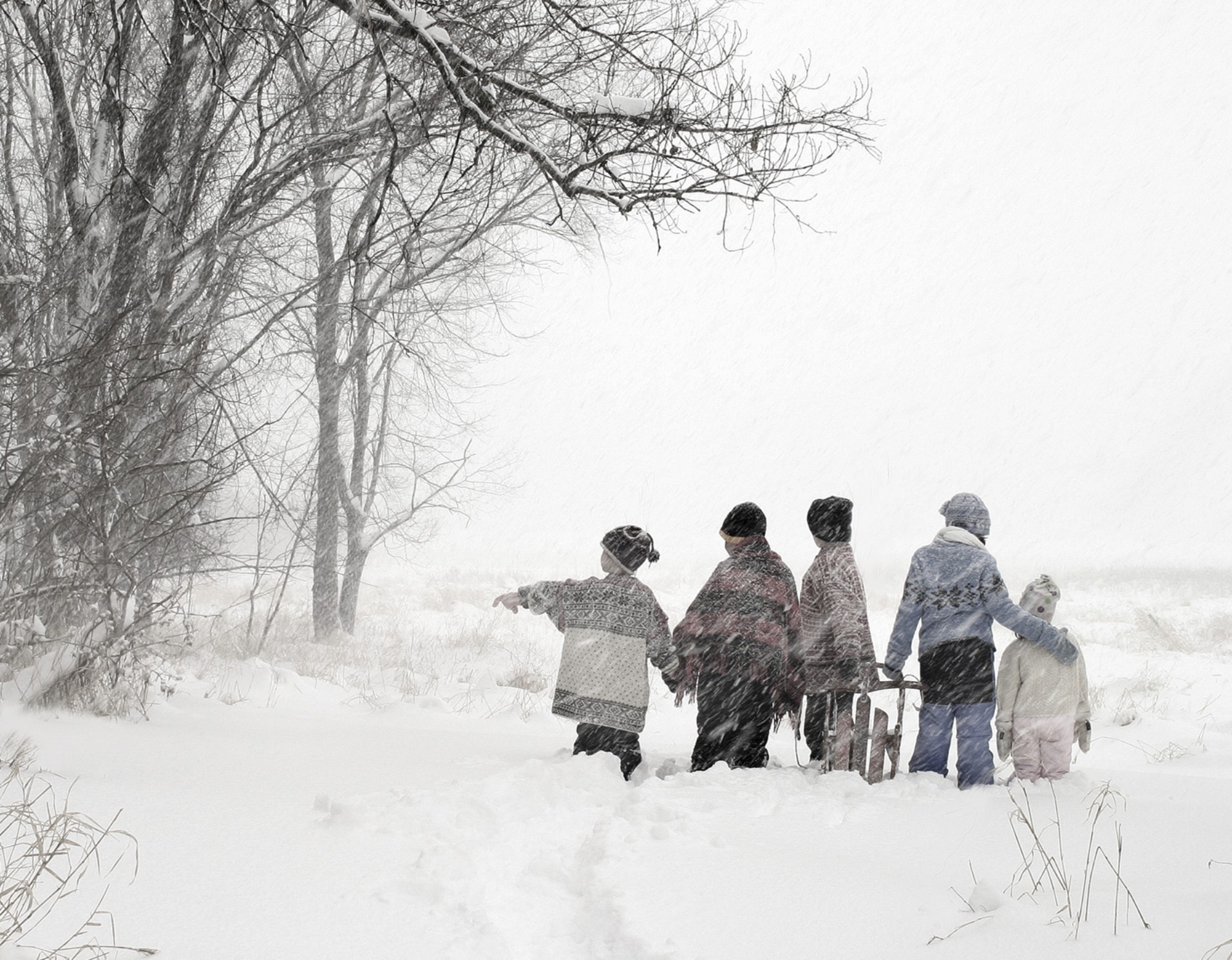
7-16
ABOUT THIS PHOTO The enjoyment of a school snow day is revealed in this photograph. Notice the leading lines created by the edge of the forest. Taken at ISO 400, f/11, and 1/60 second. ©Theresa Smerud / www.theresasmerud.com
When photographing on location, don’t forget to get permission from the owners of private property before conducting your photo shoot.
Find a field, an expansive meadow, or shoreline, and ask the children to line up on a plane parallel to your camera view. Tell them you are going to walk away, and when you wave your hand, they can move toward you, but not to look at you or the camera. They can look at each other or at something in the distance and talk to each other or tell stories or secrets. After you wave your hand, you can start shooting away. You have set the scene and given them freedom within it.
“Give a little love to a child, and you will get a great deal back.” ~John Ruskin
When they arrive by your side, ask them to turn around and go back to where they started. Follow them closely as well as from a distance, developing your photographic story as you go.
Studying Body Language, Gestures, and Movement
People watching with a keen eye should become your hobby as you seek to capture ever more interesting photos of children.
The images in 7-17 were taken as a result of intense people-watching. I began to take walks at the local beach in my town, during low tide on foggy days. Often these walks took place in the morning when the mist was lifting from the sand as the sun rose over the nearby mountain. It was so peaceful and quiet, and the few figures I saw really stood out as light silhouettes against the sand and shore. It became intriguing to observe the simplicity of the elements: the birds, footprints, dogs, and people. The low tide created vast smooth surfaces that offset the living and moving creatures.
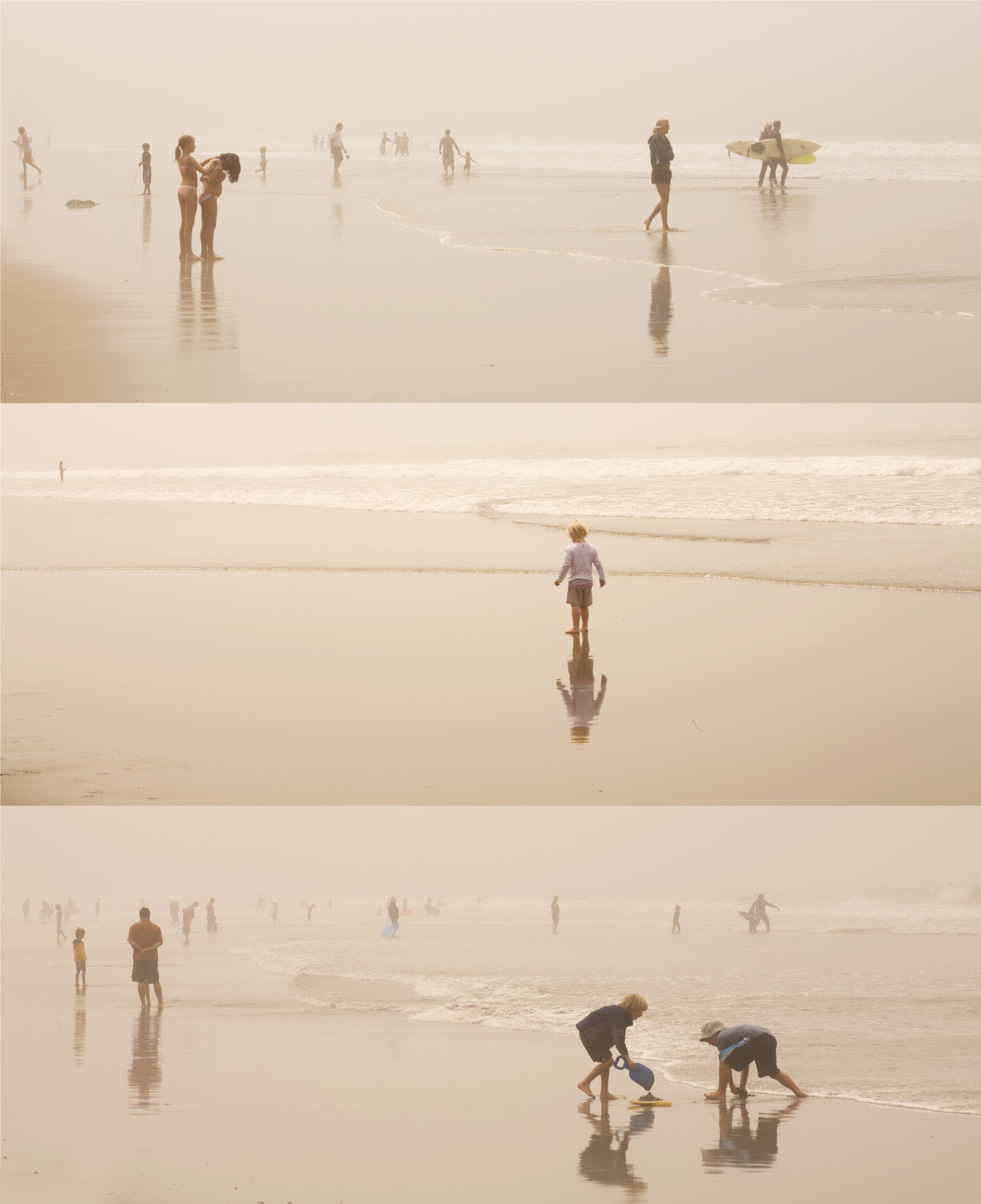
7-17
ABOUT THIS PHOTO This series of beach scenes reveals the grace of the natural movements and gestures of beach-goers ambling unaware of my camera. Taken at ISO 100, f/16, and 1/125 second. ©Ginny Felch / www.photographingchildren.com
I began to see the tide line as a music staff, and the people, birds, and dogs as notes of music for songs of life. Their gestures, as I stood far away with a telephoto lens, were spontaneous, often playful, and sometimes somber. After months of observing these intriguing scenes, my eye for children’s portraits changed. This experience encouraged me to let go more, to try to control less, to appreciate the purity and uniqueness of the natural, human gesture. You can do a similar exercise in the surroundings where you live or on your next vacation.
This type of quiet observation improves your appreciation of, and ability to capture, more natural and sensitive portraits.
Of course, while the beach may be an ideal place for you or others to observe people, the financial district in the city, a sports field, a local park, a shopping mall, or even a farmers’ market are also excellent venues.
If you are going to photograph children, watching their natural movements and spontaneous gestures can give you great insight and inspiration, as in 7-18, where the sprightly little toddler keeps her balance while walking on cobblestone, or 7-19, where the little girl digs her hands through the sand and low tide. Her reflection in the water and the line drawn to her hands creates a perfect composition. Becoming familiar with natural gestures might just make the difference between a static-looking pose and a genuine one.
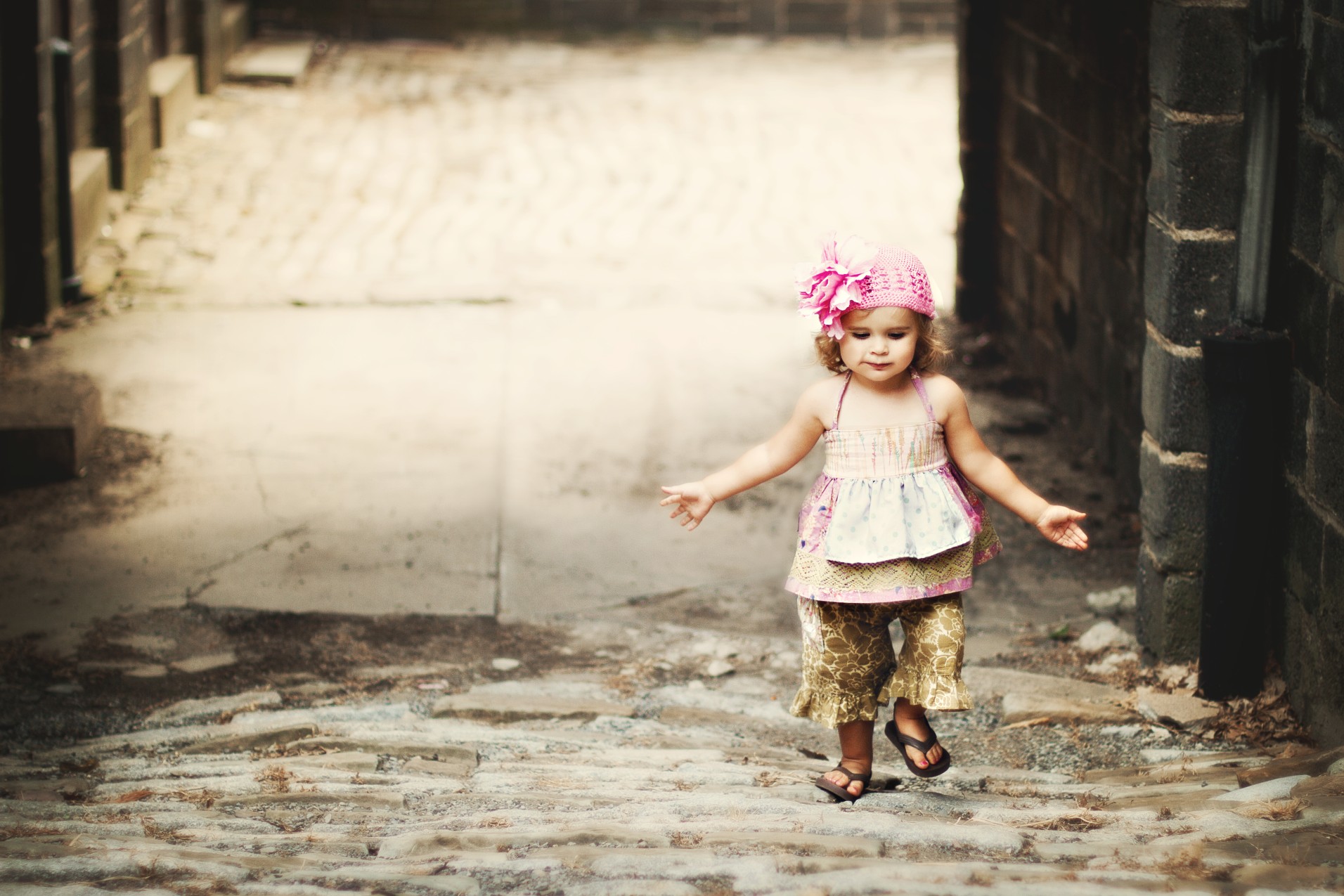
7-18
ABOUT THIS PHOTO This beautiful composition utilizing empty space and dynamic placement of the subject reveals a tiny little girl skipping along the cobblestone street. Taken at ISO 100, f/1.4, and 1/800 second. ©Jen Carver / www.jencarverphotography.com
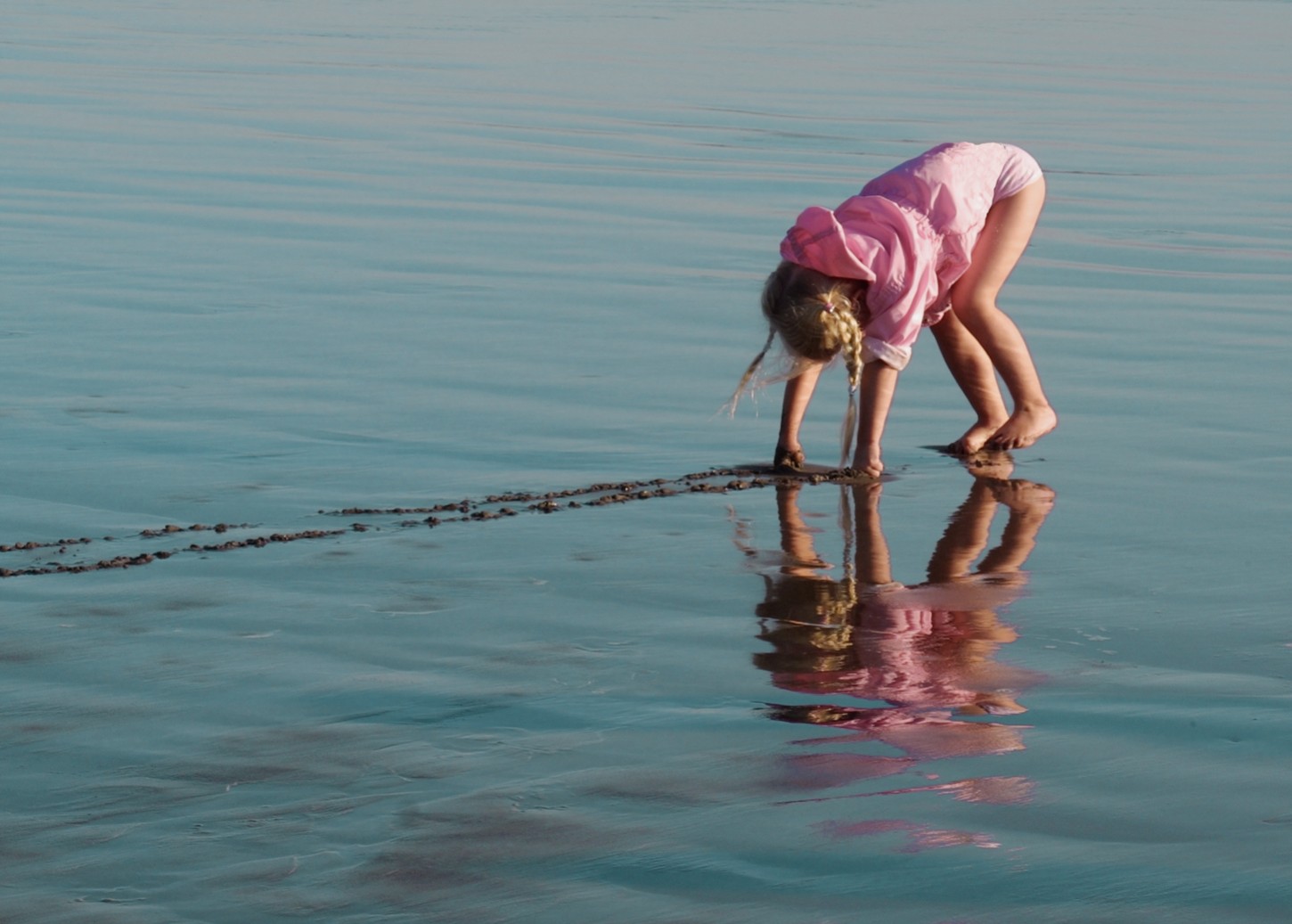
7-19
ABOUT THIS PHOTO I find it refreshing to watch children as they spontaneously frolic and invent games when left to their own devices. Taken at ISO 200, f/5.6, and 1/200 second. ©Ginny Felch / www.photographingchildren.com
The boy in 7-20 is so absorbed in his play that he seems unaware of being photographed. If the photographer had asked him to pose or try to look natural, she would not have captured the easy gesture that you see in the image. Little boys and their toy boats are classic and captivating subjects.
Chapter 8 can help you understand the specific challenges and rewards when photographing each developmental stage of a child’s life.
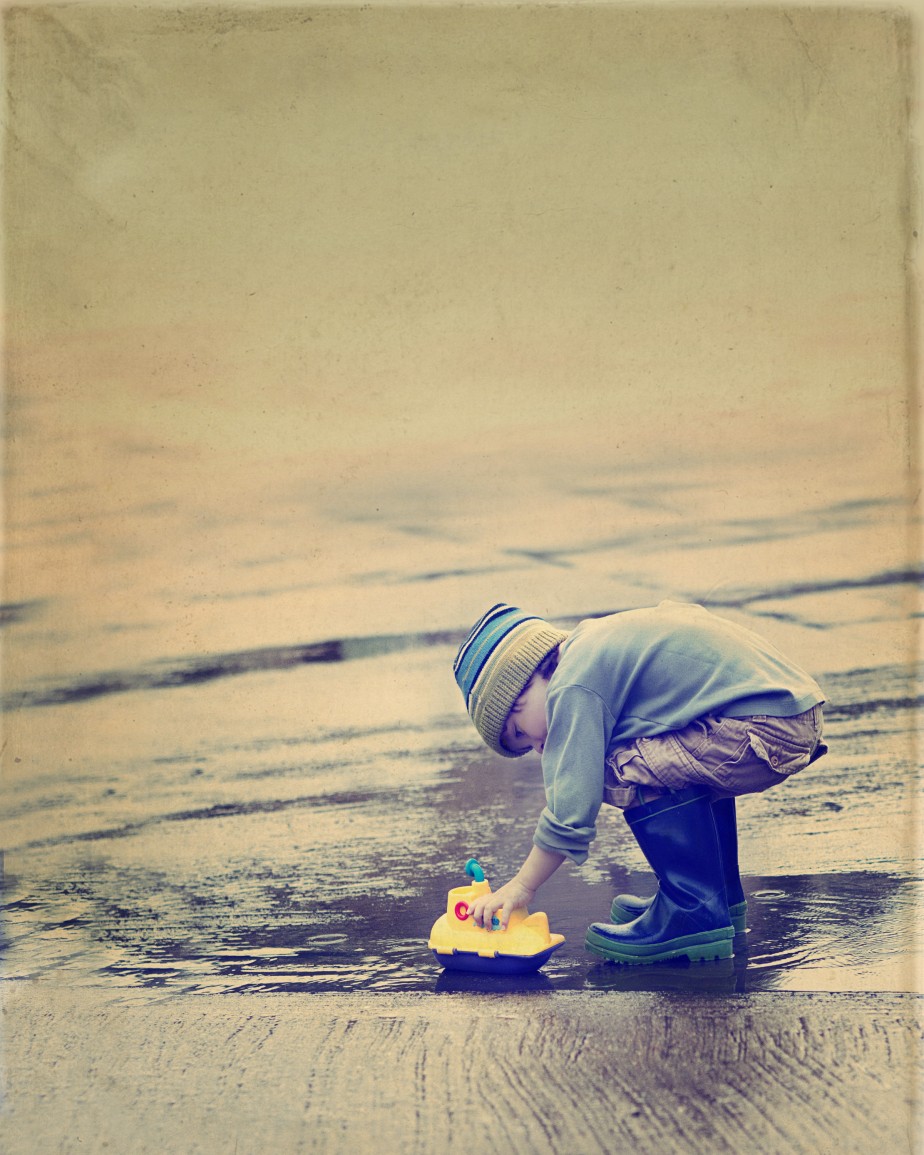
7-20
ABOUT THIS PHOTO The little boy absorbed in directing his toy boat into a channel took no notice of the photographer. Embellished in post-production using Nik filters and Nichole Van textures. Taken at ISO 640, f/5.0, and 1/200 second. ©Mary Schannen / www.melangephoto.com
Telling a Story with Your Photographs
Creating intimacy in a child’s photograph always captures the parents’ heart. A portrait is a wonderful opportunity to allow unabashed cuddling, kissing, or otherwise relating to another person, pet, or toy. Adding a warm and inviting environment and soft lighting to a child’s outward affection can enable you to create a photograph that is so much more than a snapshot.
As an exercise, the next time you are at a park or crowded shopping center, specifically watch children and parents relating. If you keep your eyes and heart open, you can see obvious and subtle exchanges between mother and child or father and child. Sometimes, it is a glance, a gentle pat, holding hands, or a quiet talk. Take a minute before you launch into your next photo shoot and observe how the children interact with their parents and use their natural body language and interactions to add life and spontaneity to your work.
While you supervise, let the children have a look at your camera and maybe even fire off a shot or two. They will be amazed at being allowed to play with an adult’s “toy.” They will want to make a lot of shots so you can use this as a reward for doing as you ask.
As you photograph children with parents or grandparents, you can invite a situation in which this kind of exchange might happen. It might take a little coaxing, such as “Can you snuggle a little closer?” You might suggest that a parent read to a child or vice versa. Dreamy looks out windows or into the sea give a sense of togetherness. A mother looking into her baby’s eyes conveys intimacy.
“The brightest light, the light of Italy, the purest sky of Scandinavia in the month of June is only a half-light when one compares it to the light of childhood.” ~Eugene Ionesco, playwright
A mom skipping down a path with a child, even if you can’t see the faces, tells a story about a relationship, as in 7-21. Don’t underestimate the power of this kind of photograph. Faces only tell part of the story.
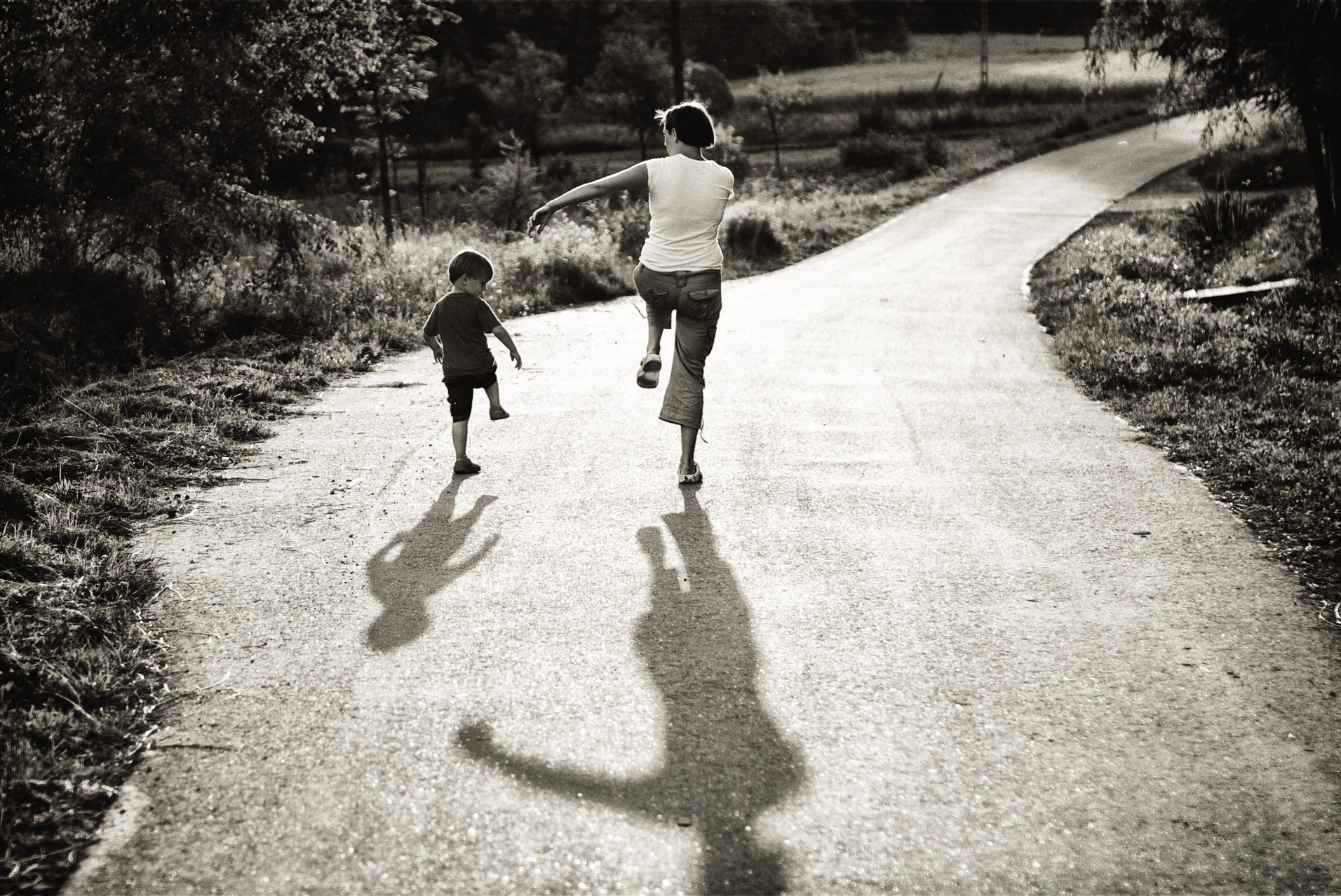
7-21
ABOUT THIS PHOTO The photograph of a mom and her son as they skip together playfully was composed elegantly on the curve of the road. The shadows are as interesting to observe as the subjects. Taken at ISO 200, f/2.8, and 1/250 second. ©Aneta Ludwig / www.anetaludwig.com
Involving a child with something or someone adored, or in play, often makes it easier to make a strong statement in a photograph. It is a great distraction to the child and often a great comfort. Consider some of these scenarios when taking photos of a child or children:
• Two sisters reading quietly on a couch
• A child playing a piano
• A toddler with her cuddly stuffed lamb
• A child and his dog or cat
• Children playing dress-up
• Sisters picking flowers together
• A father and children fishing
• A child looking at his reflection
• A child tossing stones into water
“Everything is ceremony in the wild garden of childhood.” ~Pablo Neruda
Sometimes, a poignant story about a child can also be told by photographing his essence or only part of him. For example, try photographing the following:
• Baby or toddler shoes that are well worn
• A small chair with a child’s loved doll or stuffed animal
• A baby’s feet peeking out from under the covers
• A baby’s hands in the hands of a parent
• The back of a toddler holding on to Mom’s skirt or Dad’s pants
• A summer dress blowing in the wind or hanging on a door
What you are going for here is a feeling, a mood, an expression. All of these elements take your photograph one step closer to becoming a dynamic and beautiful portrait.
The Psychology of Photographing Children
Unless you are someone whom children are attracted to immediately and unconditionally, you might at some time need a few tricks of the trade. Arriving as a stranger, carrying a strange black object (the camera), you could indeed be frightening for a younger child. Many children, however, by the age of four or five are ready and waiting with a generous smile pasted on their face the moment they realize you are there to make a photograph.
Most photographers prefer to photograph without gimmicks, tricks, or toys, but even without them, psychology is always in use. Try to beckon your innermost child to relate to the child or children before you. Take into consideration that they have been put up to this by parents, and may have been told to behave, not to make their usual faces, and so on. This suggests to them that this is going to be drudgery at best, so send the message to them that this will be fun, perhaps interesting, and over with quickly. Tell them that you don’t need for them, or even want them, to smile like they do for a school photograph. If they are old enough (over two), immediately involve them with the camera to see whether you can strike up an interest.
Can you whistle like a bird or grunt like a pig? Talking like Donald Duck is a definite plus in the business of child photography. Silly noises are helpful in getting the attention of your subject and often result in some very interesting and silly expressions. Disagreeable or frustrated young children (especially those younger than three-years-old) sometimes require toys or gimmicks to distract or please them. Even crying children can sometimes be cheered up with a simple toy. Child photographers are often great connoisseurs of toys! If you want to engage a child in a photo session, try packing a few items like these: quacking ducks, barking dogs, oinking pigs, harmonicas, whistles, clickers, castanets, balloons, or bubbles.
My very favorite is Obie, also known as Bug Out Bob — the rubber doll shown in 7-22. When you squeeze him, the ears, eyes, nose, and mouth pop out. I use Obie sometimes to transfer any negativity from the child to the puppet. For example, if the child exhibits “attitude” (negativity, petulance, or scowling), out comes Obie to take over that sentiment! It never fails.
Another good time to get out the “sure thing” toy is the end of a session when the children are finished, but you are not! In order to engage children, ask them questions such as:
• What is your favorite flavor of ice cream?
• Do you like pizza?
• Do you ever misbehave?
• Does your sister have a boyfriend?
These questions are sure to evoke unique expressions and distract the children from the camera.
Children are the least-inhibited humans on the planet. Take advantage of this unselfconscious time in their lives to capture their wonder and innocence. Avoid the temptation to make a photo shoot more complicated than it has to be. Forget the props and extraneous camera equipment and just spend some time getting to know your little subjects.
Talk to them and find out what they like. Put the camera down for a minute and listen to them. Let them look over your equipment and explain what you are going to do. Once they are more familiar with you and know that you are truly interested in them, getting honest expressions is easy.
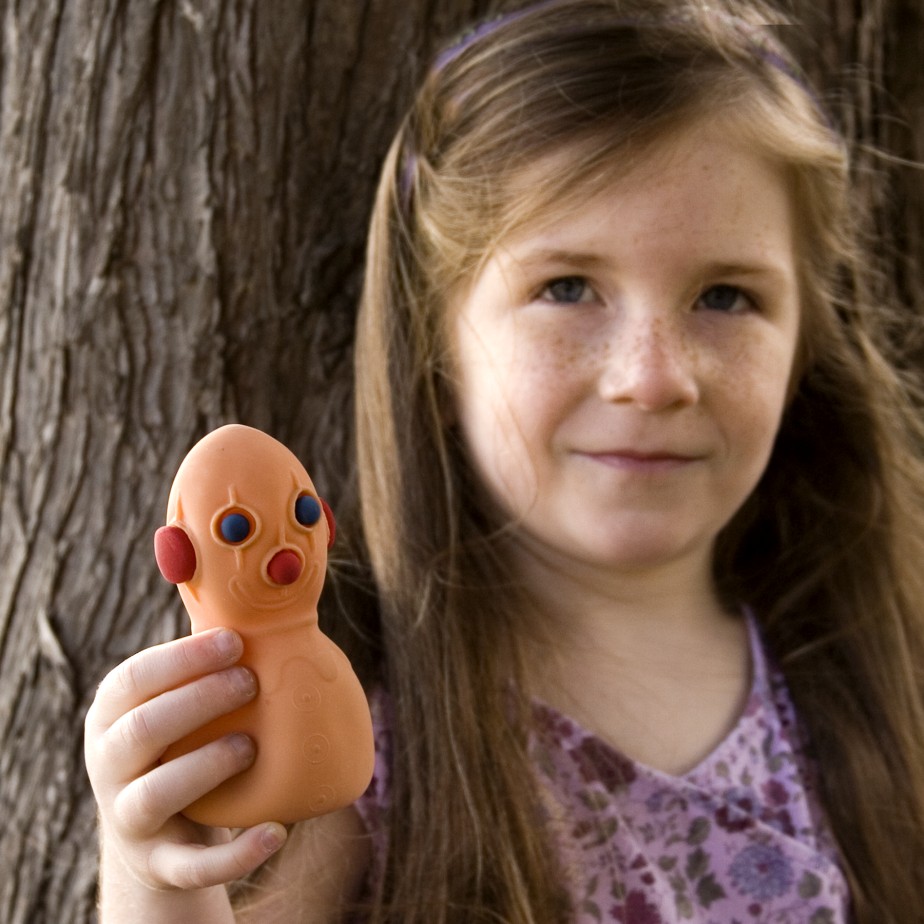
7-22

7-23
ABOUT THESE PHOTOS Daisy demonstrates how Obie works. The ears, eyes, nose, and mouth pop out to the delight of children when I squeeze him. Naughty Obie! Taken at ISO 640, f/5.0, and 1/200 second. ©Ginny Felch / www.photographingchildren.com
Assignment
Tell a Story
Take a photo that captures a child’s image — with a sibling or parent or not — telling a story. You can use a prop if you want, but be careful not to be too cutesy or have the subject(s) too posed. That is the challenge. It might literally be posed, but it should look natural to the viewer. Practice some of the approaches you have learned in terms of involving yourself with the child in order to evoke a sense of comfort and flow. This should reflect back into your image.
Here the assignment was completed with this photograph of a “special ritual the siblings have of placing their foreheads together. It is easy to see the trust and adoration between the two, especially from the younger one with his expressive eyes.” This photograph won first prize on my Facebook Photographing Children contest, and Shari won a full edition of Adobe Photoshop. Taken at ISO 1000, f/4.5, and 1/80 second.

©Shari Yasseri
Remember to visit www.pwsbooks.com after you complete this assignment and share your favorite photo! It’s a community of enthusiastic photographers and a great place to view what other readers have created. You can also post comments, read encouraging suggestions, and get feedback.

